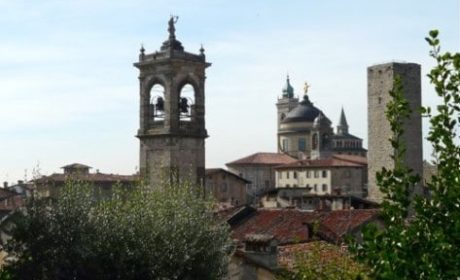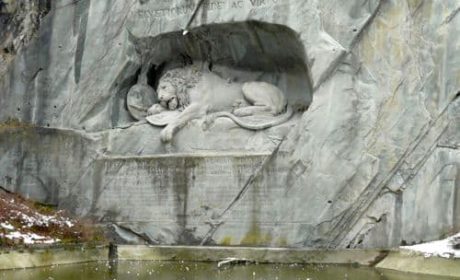Spending two days in Lucerne, is a great way to begin or end a Rhine River Cruise. The land extension to this lovely Swiss city is well worth your time, especially because it gives you the chance to spend a day in the Swiss Alps.
Alan and I had planned to see Lucerne after our Christmas Markets Cruise until a back injury landed me in a Swiss hospital to wait for a Medjet escort home. What a bummer.
However My Itchy Travel Feet featured writer, Debi Lander of ByLanderSea, spent two lovely days in Lucerne. I recommend that you read Debi’s travel tips for what to see and do. Alan and I will be following her advice when we finally travel to Lucerne again.
When I was growing up, my family didn’t have the extra budget for travel. We vacationed at my grandparent’s house. But stories in books took me to far-off locations, and I sometimes imagined myself on distant shores.
One of my favorite books was Heidi. The story, written by Johanna Spyri, features a young orphan girl sent to live with her grandfather in the Swiss Alps. She developed a deep love of the mountains and nature, something I also feel and understand. Reading Heidi and studying the illustrations made me wish to see the Alps, chalets, and grazing cows.
I finally got to spend a brief sojourn in Switzerland when I signed up for a river cruise starting in Basel. The boat would follow the Rhine River to Cologne, Germany, and my travel buddy Judy would join me for the adventure.
Another friend who took the river cruise recommended that I add time in Lucerne, and I’m so glad I listened to her advice.
Table of Contents
Traveling to Lucerne by train from Zurich airport
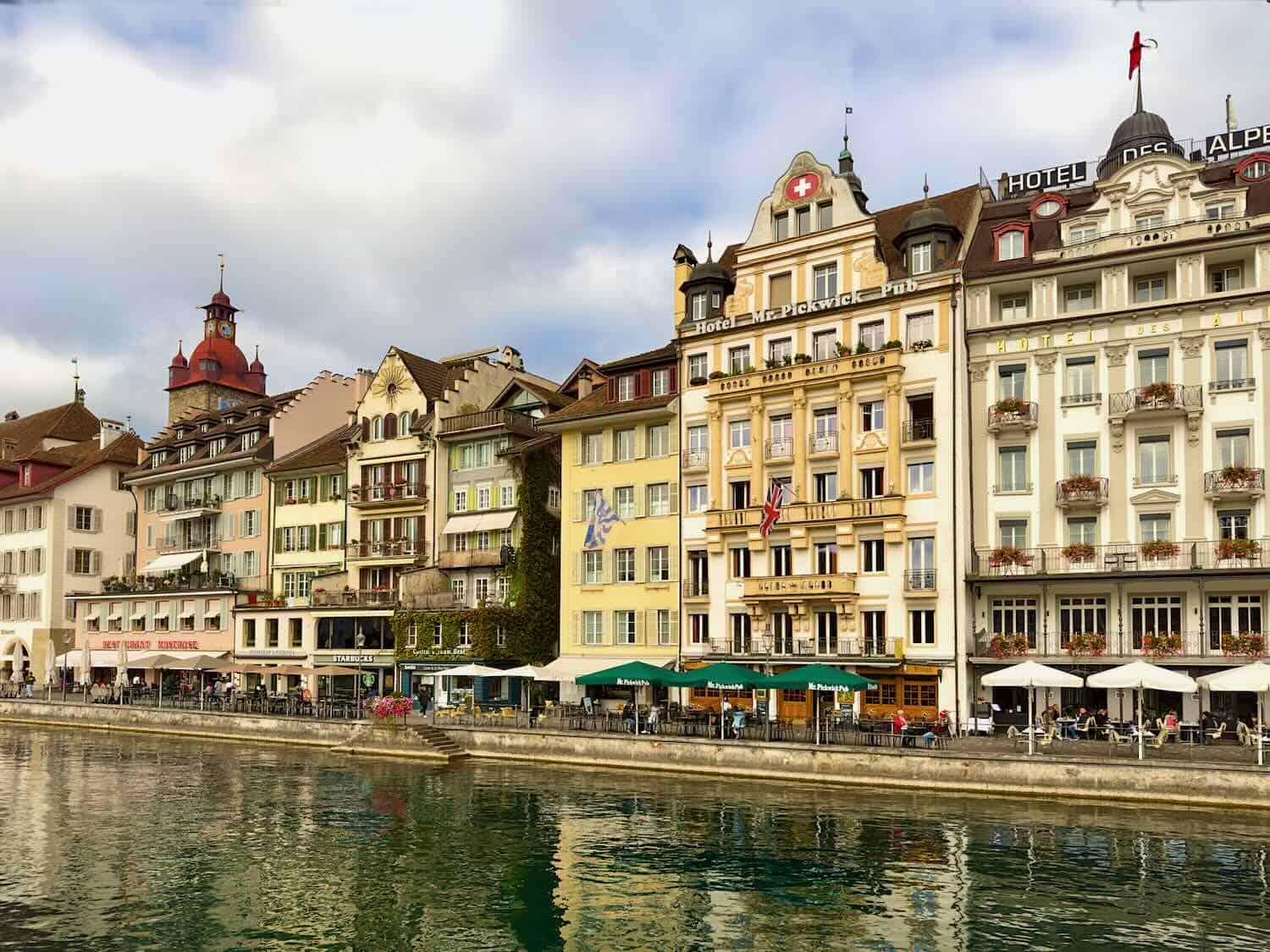
As I expected from generalizations about the Swiss, the Zurich airport was clean and efficient. We walked across the street and boarded a train directly to Lucerne. Swiss Rail makes it easy. The trains run on time, the seats are comfortable, and the windows provide panoramic views.
After an hour, the train arrived in Lucerne, and a five-minute walk from the railway station brought us to the Hotel des Alpes, the lodging I’d reserved bordering the lake.
The beauty and ambiance of the city can’t be overstated. I suddenly felt so alive and happy. I was in Switzerland!
Boomer Travel Tip
MedjetAssist Members who are hospitalized 150 miles from home receive medical transport to a home-country hospital of choice. Memberships from $99.
Day One: Exploring Lucerne Old Town
Chapel Bridge
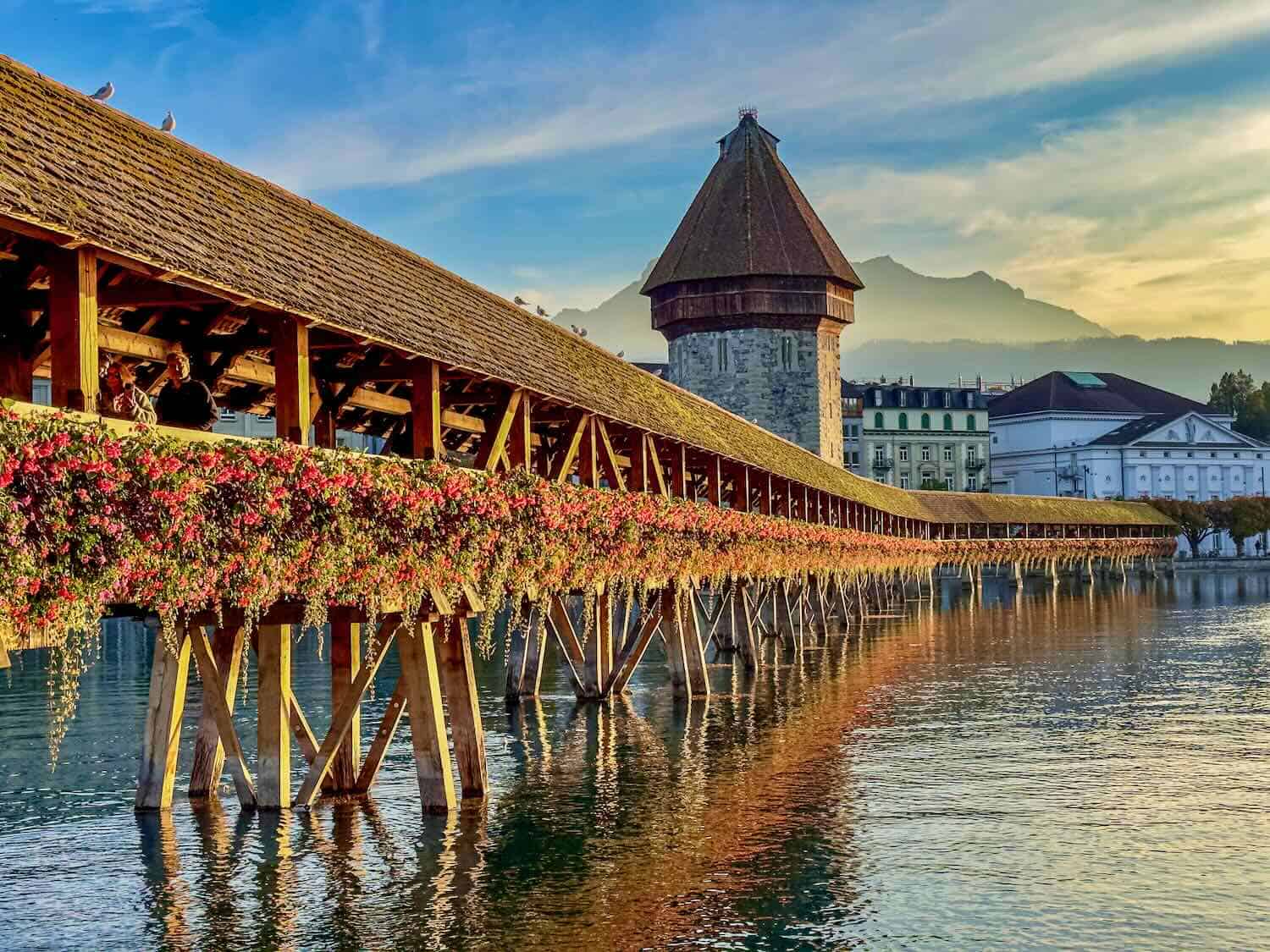
We dropped our luggage and set off to explore the city by crossing the iconic Chapel Bridge. This enchanting wooden bridge, first constructed in 1333, stretches across the Reuss River but takes a few unusual angles.
It’s considered one of the oldest covered wooden bridges in Europe. The bridge currently features lush flower boxes and historical religious paintings on the beams.
The historic old town of Lucerne
We crossed back and then strolled through the pedestrian-only historic center, just a block beyond Lake Lucerne. (Car-free downtowns are a real plus for tourists, especially when dealing with jet lag.)
We encountered fascinating, centuries-old houses painted with historical scenes or artistic details from former artisan guilds. Each turn revealed charming fountains, bountiful and vibrant flowers, quirky rooflines (hard to photograph), and inviting shops.
Lion Monument
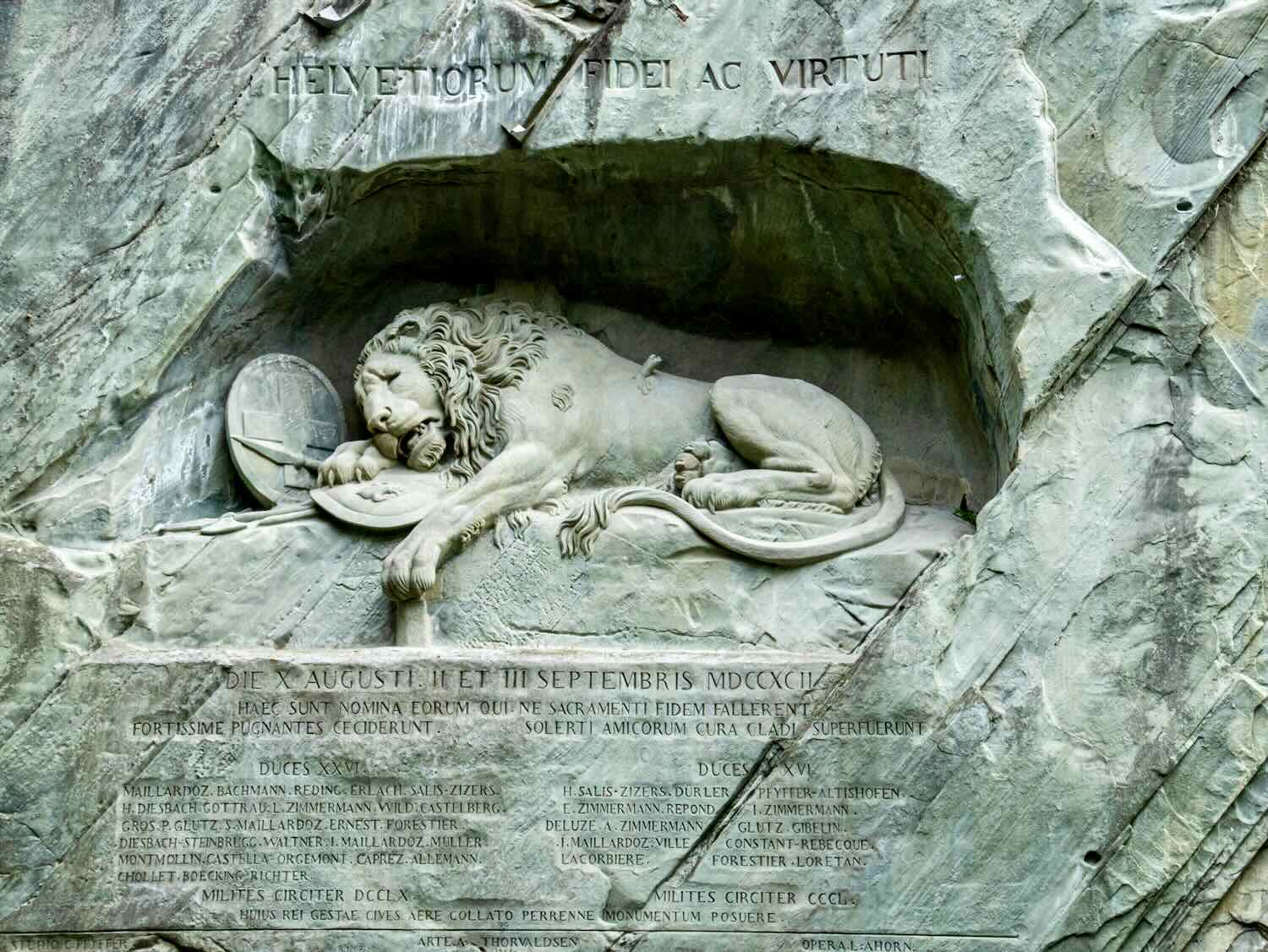
I prepare for travel ahead of time by reading guidebooks, blogs, and tourist information and talking to other travelers. They all told me to visit the Lion Monument constructed in 1821. So, Judy and I headed there to see the famous landmark.
The Lion of Lucerne became a poignant tribute to the Swiss Guards who lost their lives during the French Revolution in 1792. There’s no admission; you walk up to a large sandstone cliff and see a sculpture of a dying lion wounded and draped in the Swiss flag.
The lion’s expression is one of pain and sorrow. When Mark Twain visited, he called it “the most mournful and moving piece of stone in the world.” I totally agree.
Glacier Garden Museum
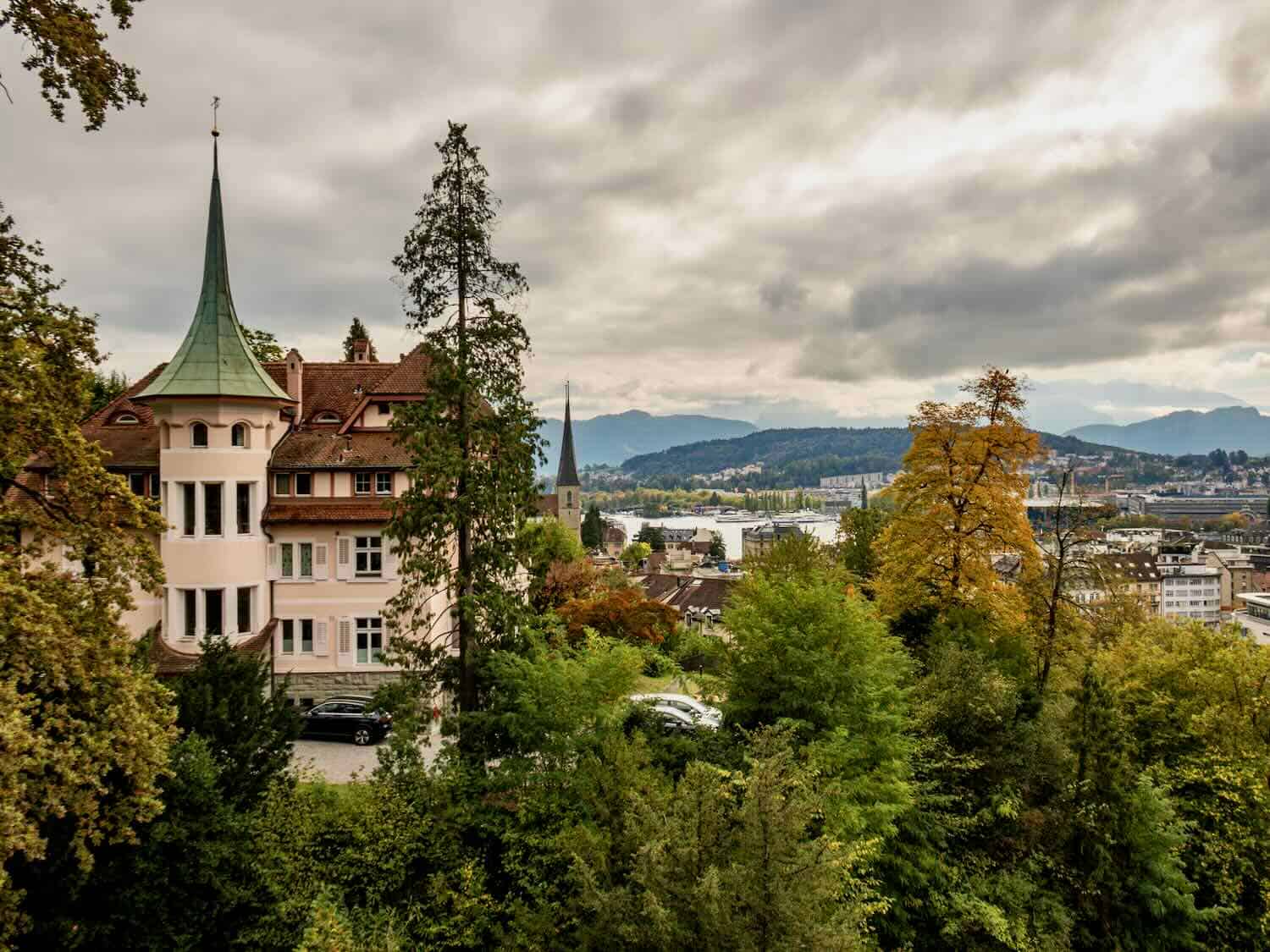
Adjacent to the monument lies the Glacier Garden Museum (Gletschergarten) an attraction that became a delightful surprise. The museum’s interactive exhibits take you on a journey through geological history, the Ice Age, and the forming of the Alps.
You wander through a cave-like tunnel and climb stairs that lead to rock gardens offering fantastic views above the lake and city. I could see Mt. Pilatus in the distance, rising approximately 7,000 feet.
Unexpected fun came when we entered the Museum’s Mirror Maze and lost our way among our mirrored reflections cast along the path. This hall of 51 mirrors was built in 1896 for the Swiss National Exhibition in Geneva and moved to Lucerne in 1899.
The multiple reflections overwhelmed us; we became confused and left exhausted from laughing at ourselves. I absolutely recommend a visit.
Sampling Swiss Delicacies
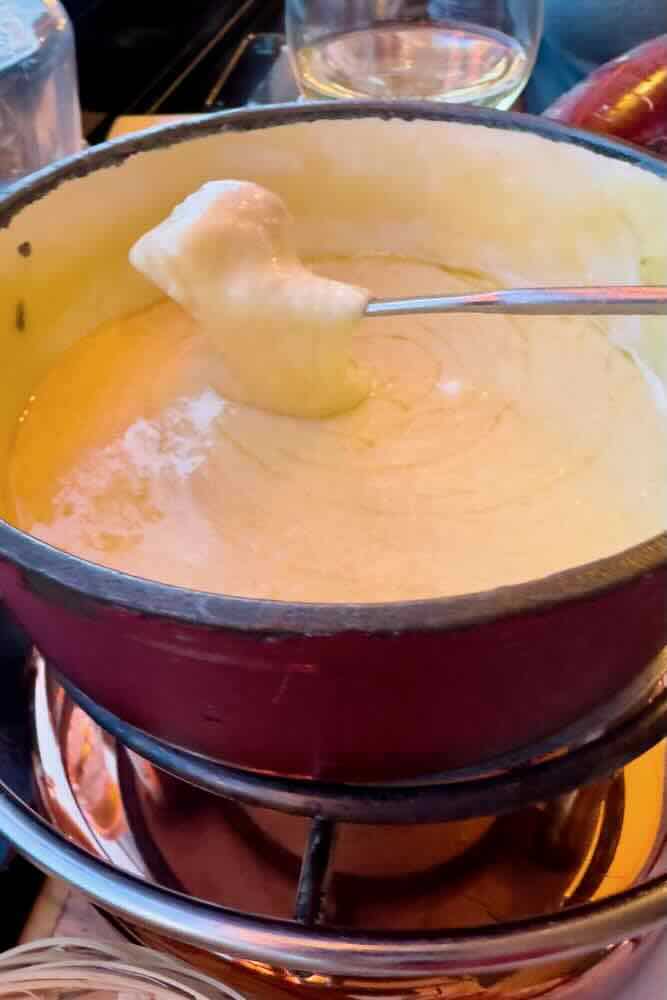
As evening descended, we indulged in the quintessential Swiss experience—lakefront dining with a steaming pot of cheese fondue. If that wasn’t enough, we paired it with decadent Swiss chocolates. Dinner became the perfect end to a travel day full of exploration. We slept well.
Day Two in Lucerne: Golden Day Round Trip Tour
We embarked on the Golden Day Round Trip Tour the next morning, day two of our Lucerne visit, starting with a foggy boat cruise. The weather brought gray, low-hanging clouds, but I still enjoyed being on the water.
Boat cruise across Lake Lucerne

The boat took about 30 minutes to cross the lake and then landed where we could walk to the entrance to the most vertical cogwheel railroad in the world. There, the speedy cogwheel train runs up to Mt. Pilatus.
Cogwheel train to Mt. Pilatus
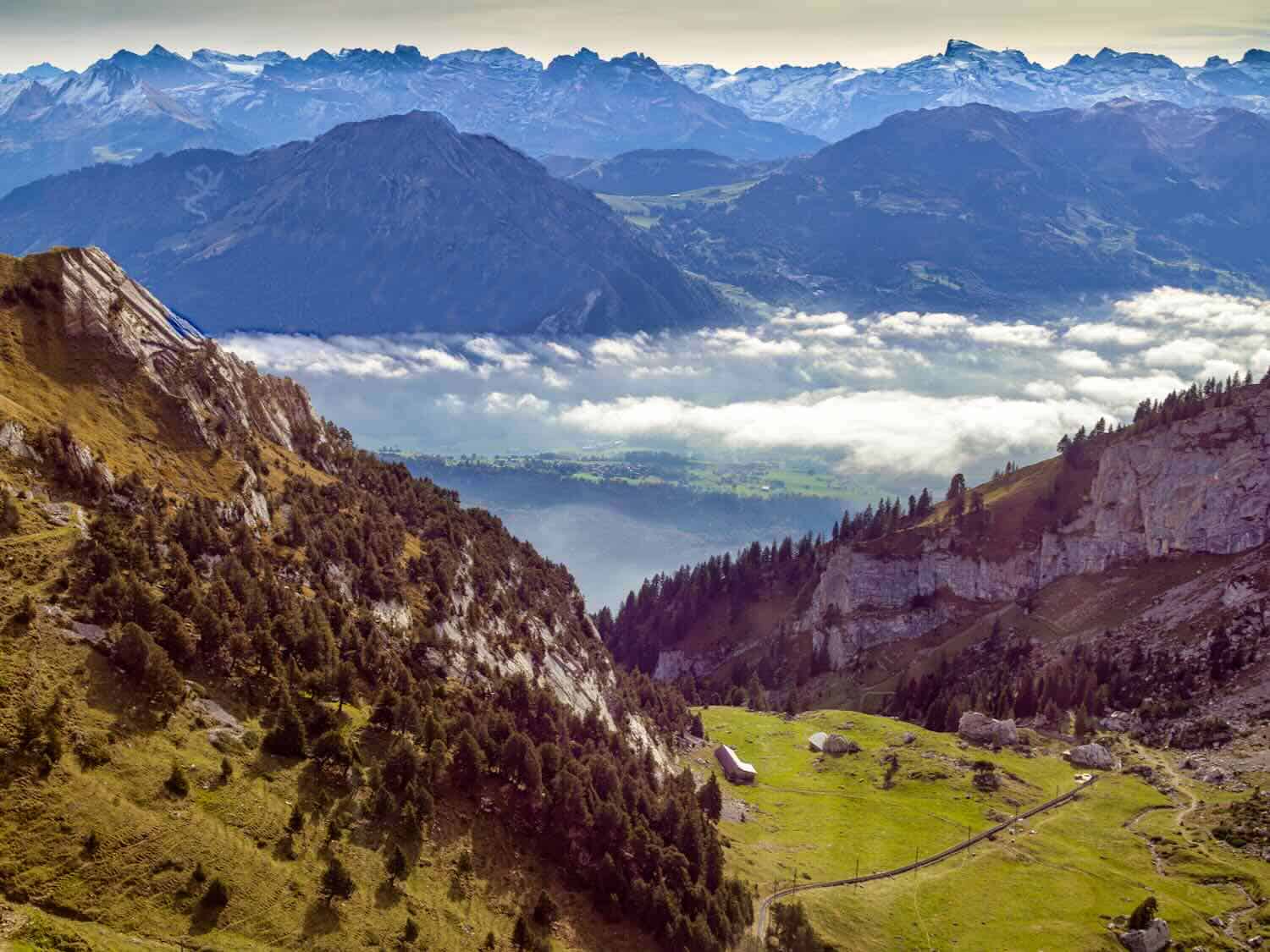
As we climbed up and up, we saw ever-changing landscapes. Leaving behind the fog-enshrouded lake, we ascended to clear, sunny skies at the rocky summit.
We took a deep breath and basked in the soaring panorama of the Alps: Eiger, Mönch, and Jungfrau, a lifelong dream come true.

The quick change from being in town to the top of the Alps transcended all. Everyone was in love with the magical landscape.
We encountered some intrepid hikers by the coffee stand who had made the climb—a feat I admired but couldn’t imagine attempting.
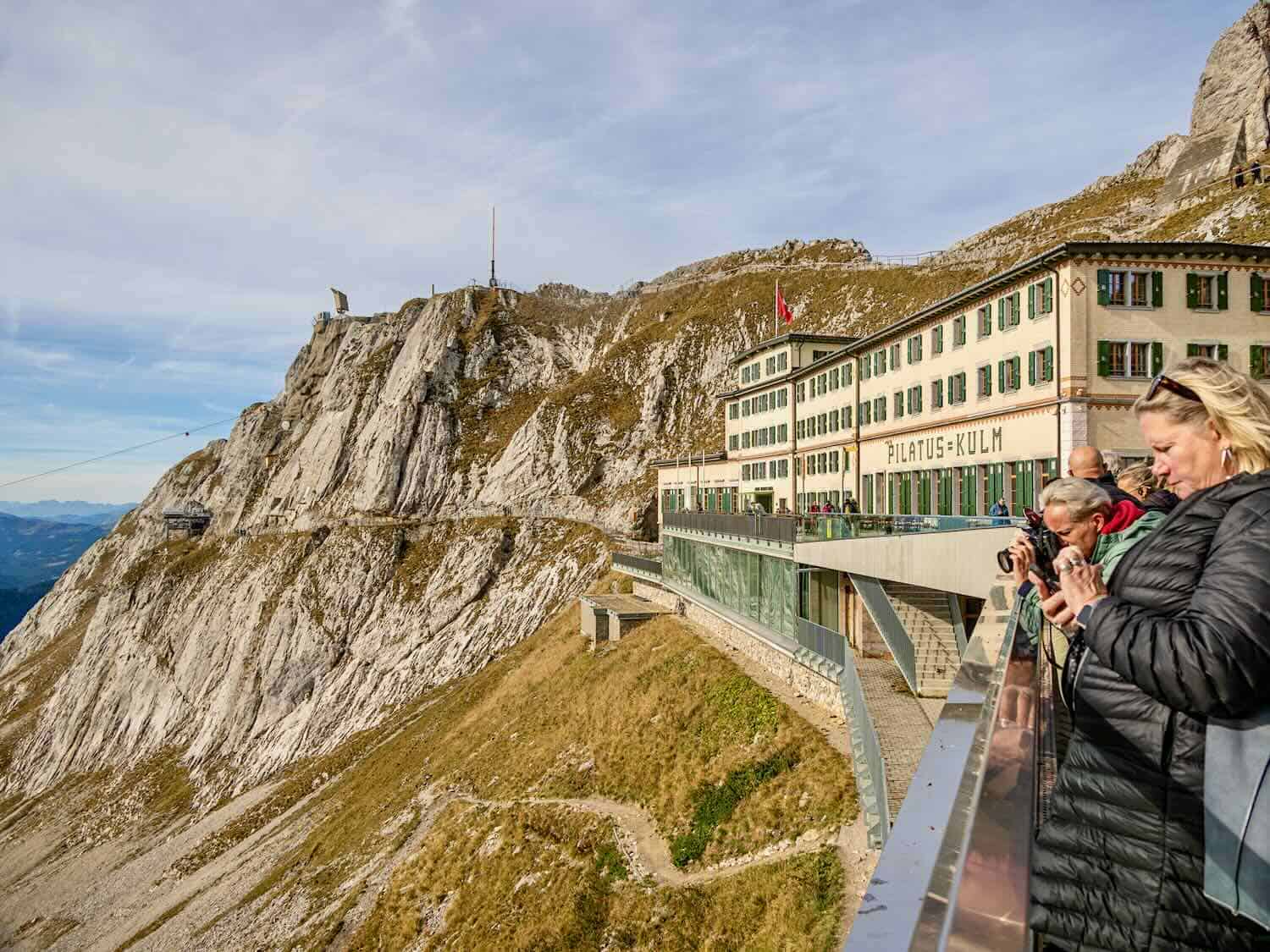
The mountain’s viewpoints are spectacular, and we made our way around to various lookout points. I really liked the fact that this tour left you to your own time schedule.
Boomer Travel Tip
If hiking the Swiss Alps is on your bucket list, you’ll want to read our tips for hiking through the Swiss Alps.
Taking the Dragon Ride aerial cableway to Kriens
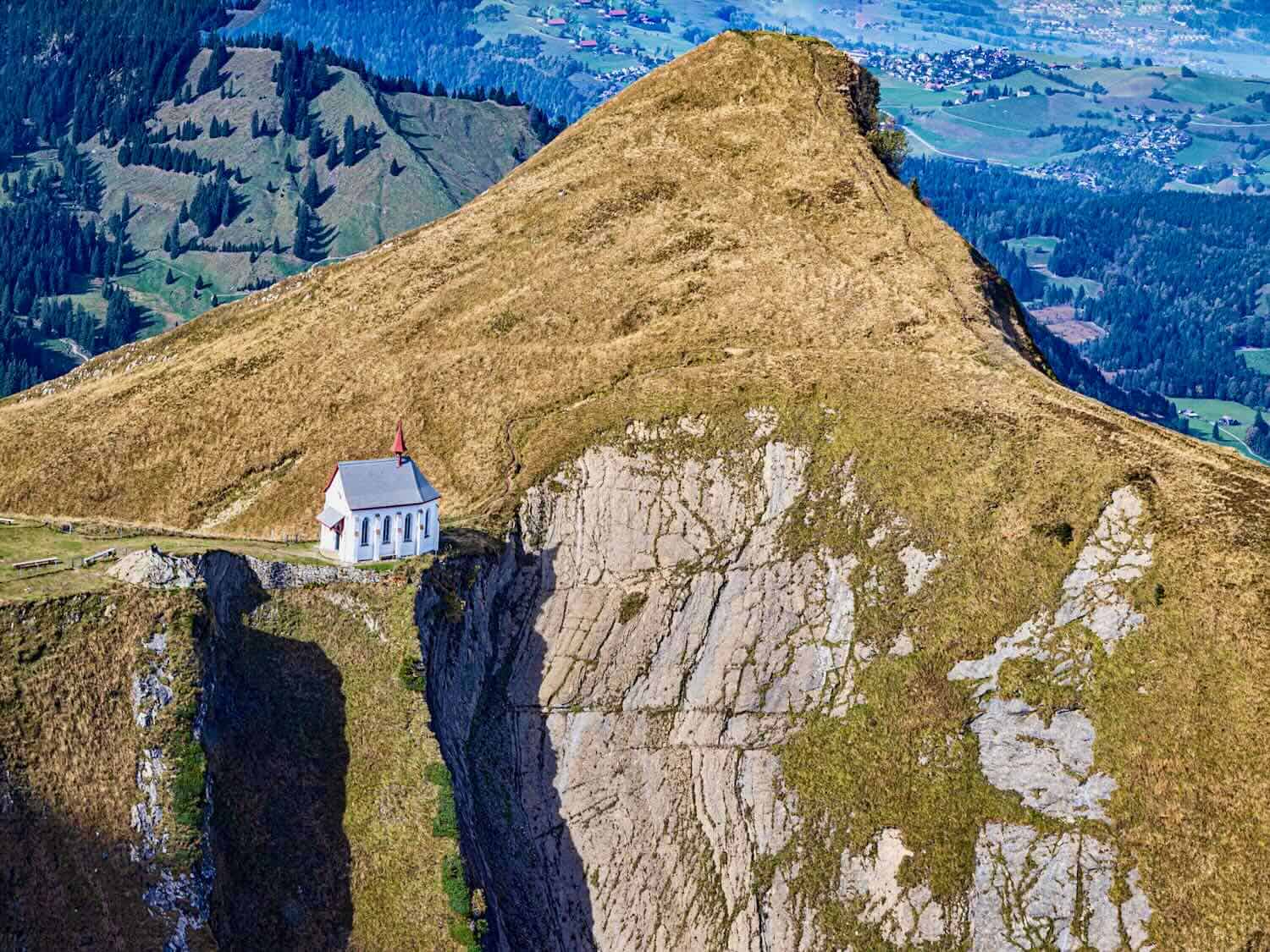
When we were ready, we descended on the Dragon Ride, an aerial cableway to Kriens that offered even more stunning scenery.
Grandparent Tip: If traveling with children, check out the free interactive animated dragon story in the Dragon World area within the Pilatus-Kulm building.
While shooting photos, I noticed a tiny church clinging to the edge. Further research reveals that this little shrine, known as the Klimsenhorn Chapel, was built in 1861 by the Klimsen family, local hoteliers.
The church is dedicated to St. Dominic, has a simple altar and wooden benches, and can accommodate about 10-15 people. Sorry we missed it. Tip: You can make the 20-or-so-minute downhill hike from the summit to visit this alpine chapel.
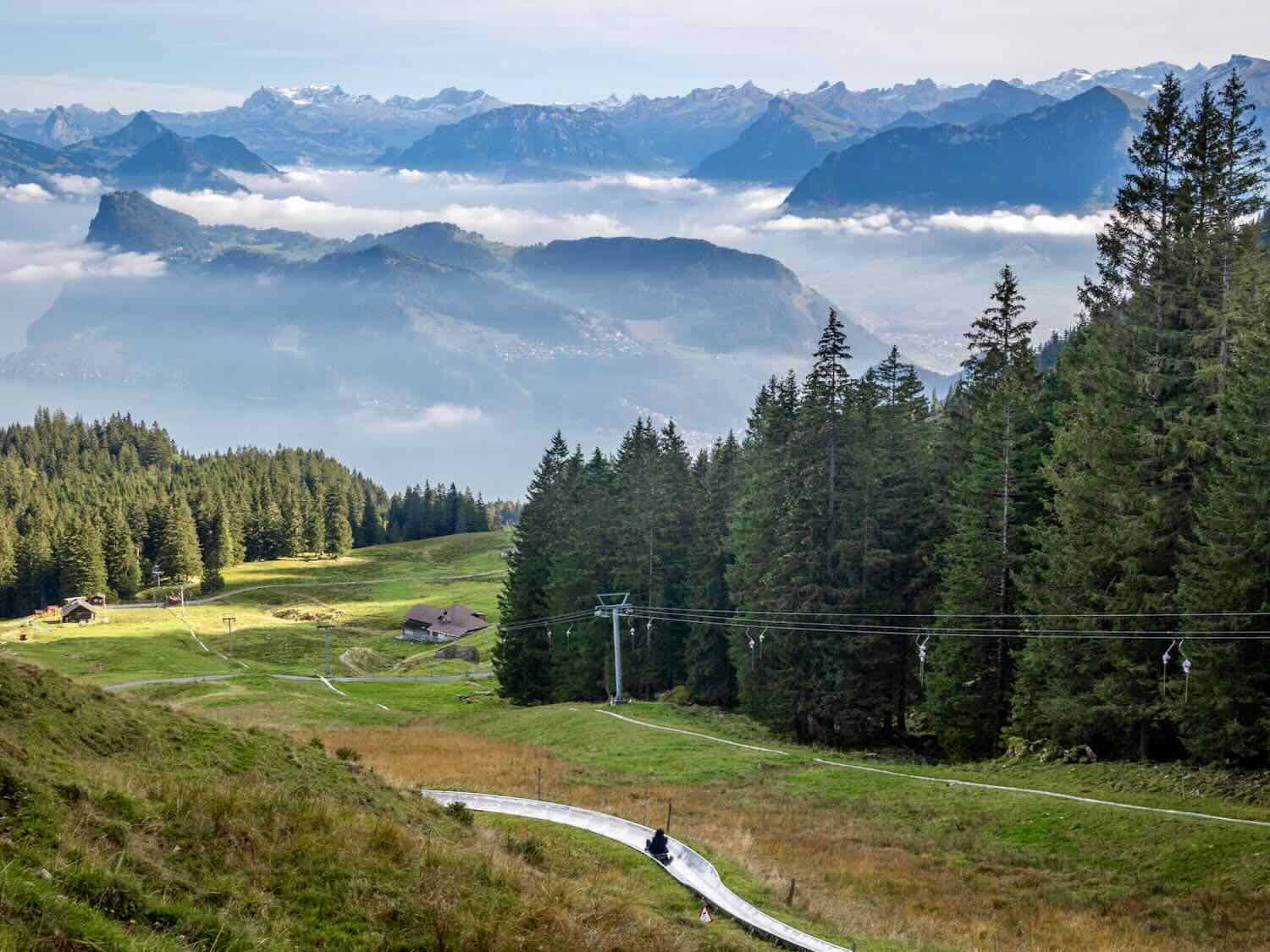
Instead, we grabbed a sandwich and paused to watch adventurous folks tobogganing and tackling rope courses. You could spend a few hours here, but we reluctantly moved on to a second gondola.
Gondola ride back to Lucerne
The cable car ride dropped us back in Lucerne’s outskirts. A well-marked short trail led us past a cemetery, where we stopped to take a look and went on to a bus stop in the city center.
We didn’t linger in this business district; we just hopped on the next bus—our fare included with the day trip.
Upon reaching our hotel (never underestimate the convenience of an ideally located hotel), we lazed, snacked on Swiss chocolates and napped.
Sunset cruise on Lake Lucerne

Our day wrapped up with a one-hour sunset cruise on the lake. Walking to the boat launch gave us a chance to enjoy the marina and shops along the boulevard.
Unfortunately, the sunset itself proved elusive. However, the cruise’s narration provided insightful tidbits about the area, answered many questions, and added another layer to our Lucerne experience.
We enjoyed the later evening near our hotel, walking around the lakefront and sipping a nightcap at the outdoor bar.
Exploring before a train ride to Basel
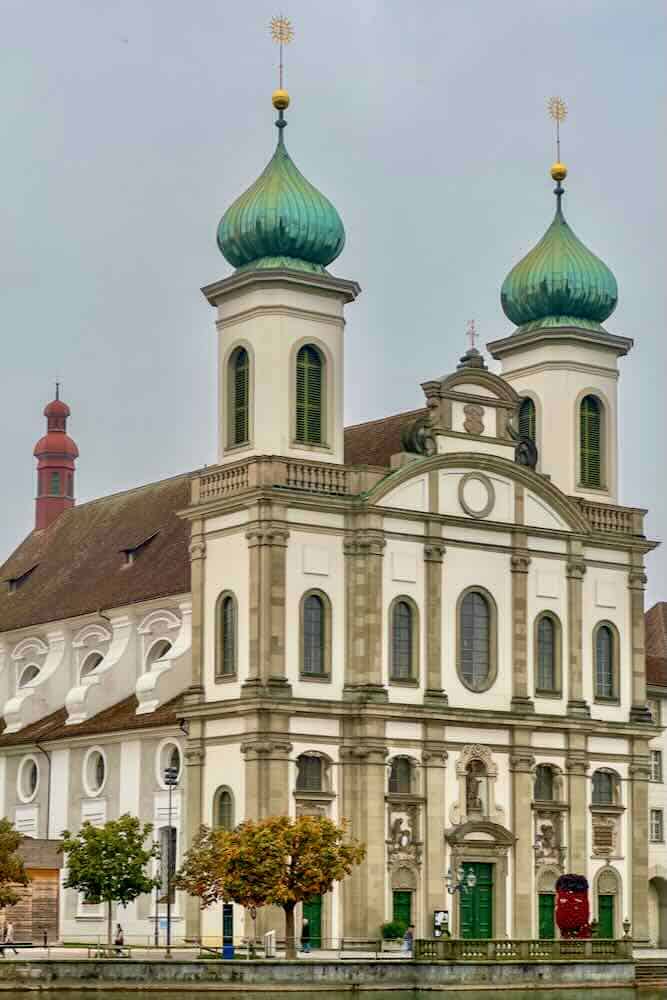
Before catching a train to Basel the following morning, we tried to visit the Jesuit Church but found it closed. Built between 1666 and 1677, it represents one of Switzerland’s finest examples of Baroque architecture. We missed the richly decorated interior, its grand ceilings, elaborate altars, and beautiful side chapels.
Instead, we stumbled upon a fascinating cuckoo clock store (very pricey) and sampled more delectable chocolates—very fattening but a sweet consolation.
More things to see in Lucerne
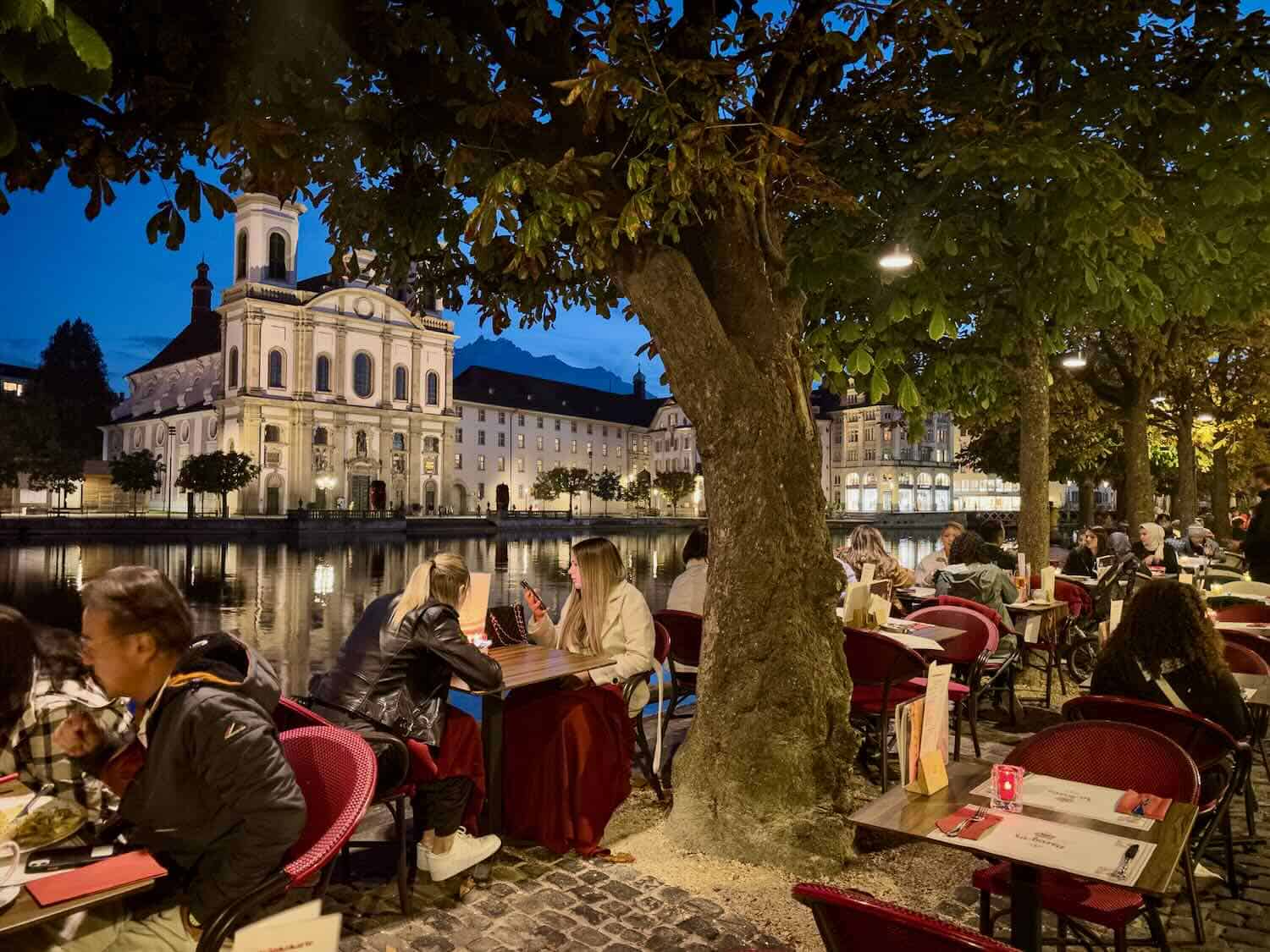
Even with two days, we missed some of Lucerne’s museums. I would have enjoyed the Richard Wagner Museum in the villa where the composer spent his final years. I’m told the museum offers insights into Wagner’s music and personal life, with original manuscripts, letters, and personal artifacts on display.
We also missed the Swiss Museum of Transport located near the train station. It features a vast collection of vehicles, including trains, planes, automobiles, and boats, as well as Interactive exhibits, a planetarium, and a space shuttle launch simulation.
I’m so grateful we included this city in our itinerary and the day trip to the Alps. Lucerne turned out to be a photographer’s paradise and a perfect introduction to our Swiss and German adventure. If you’re planning a trip, spend at least one night in Lucerne—two days are even better —you won’t be disappointed!
Tip: Many river cruises start in Basel and list an excursion to Lucerne. However, the stop is rarely more than an hour. That is absolutely not enough time for this pretty city. Read your cruise itinerary carefully.
Another unusual idea would be to spend a night at the hotel, such as the Hotel Pilatus-Kulm, at the Mount Pilatus Summit.


